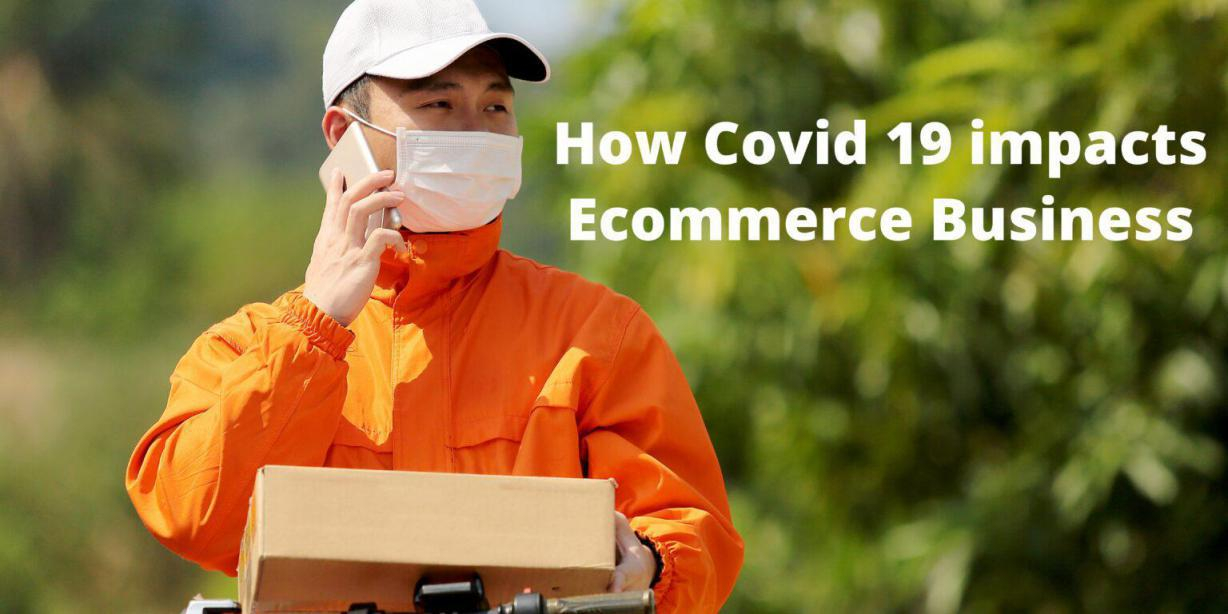
How COVID-19 Has Changed The Future Of Ecommerce
COVID-19 has reshaped our lives. This is a bitter fact which simply cannot be disputed. One of the areas that has been affected the most is our lifestyle; including how we buy and what we buy. In short, the pandemic has forced us to redefine our priorities and differentiate between necessity and luxury with a completely different lens. Lockdowns and the contraction of the disease have changed the dynamics of shopping completely. Folks across countries have shifted from “Feel Good” products to everyday necessities such as groceries, medicines and ready-to-eat food.
It is interesting to note that the bulk of the action for the above goods is taking place online. It seems E-commerce has come of age, and evolved dramatically overnight, turning into a messiah for billions of people. The e-commerce industry is witnessing an unprecedented surge in sales, encountering a different breed of shoppers ( offline, daily cash buyers ) and a deviating product interest.
The only positive pick from this pandemic is the future of e-commerce. It looks like this industry is heading for a boom, although this success may be limited to just a few products and services.
The Impact of COVID-19 on E-commerce
A significant effect of the COVID-19 pandemic on e-commerce has been the acceleration of the move to online buying as well as the emergence of new business opportunities and obstacles.
People were compelled to stay at home and limit their interaction with others as a result of the pandemic. As a result, more individuals started shopping online for everything from groceries to clothing to electronics. Global e-commerce sales increased by 28% in 2020 to $4.9 trillion.
The Future of Ecommerce After COVID-19
The COVID-19 pandemic has accelerated the growth of e-commerce, and this trend is expected to continue in the years to come. The future of e-commerce will be shaped by a number of factors, including:
-
The continued growth of mobile commerce
More and more people are shopping online using their smartphones and tablets. In 2022, mobile commerce accounted for 72.9% of all e-commerce sales worldwide. This trend is expected to continue, as more people adopt mobile devices and use them to shop online.
-
The rise of social commerce
Social media platforms are becoming increasingly important for e-commerce businesses. In 2022, social commerce sales worldwide were estimated to reach $1.2 trillion. Social commerce allows businesses to reach a wider audience and connect with customers in a more personal way.
-
The growth of artificial intelligence (AI)
AI is being used to improve e-commerce operations in a variety of ways, such as recommending products to customers, personalizing the shopping experience, and optimizing pricing. AI is expected to play an even greater role in the future of e-commerce, as businesses look for ways to improve the customer experience and make it easier for customers to find the products they want.
-
The development of new technologies
New technologies, such as augmented reality (AR) and virtual reality (VR), are being developed that have the potential to revolutionize e-commerce. AR and VR can be used to create immersive shopping experiences that allow customers to try on clothes, test drive cars, or even visit a store without leaving their home.
The future of e-commerce is bright. The continued growth of mobile commerce, social commerce, AI, and new technologies will create new opportunities for businesses and make it easier for customers to shop online. Businesses that are able to adapt to these trends and embrace new technologies will be well-positioned to succeed in the years to come.
Here are some specific trends that are expected to shape the future of e-commerce:
-
Personalization
E-commerce businesses will increasingly use data and AI to personalize the shopping experience for each customer. This could include recommending products that are relevant to the customer's interests, offering discounts based on past purchases, or suggesting similar products that the customer might like.
-
Convenience
E-commerce businesses will focus on making it as easy as possible for customers to shop online. This could include offering free shipping, same-day delivery, or the ability to return items easily.
-
Sustainability
E-commerce businesses will be increasingly focused on sustainability. This could include using recycled packaging, offsetting their carbon emissions, or offering products that are made from sustainable materials. -
Transparency
E-commerce businesses will be more transparent about their operations. This could include providing information about their supply chain, how they are pricing their products, or how they are handling customer data.
The future of e-commerce is full of possibilities. Businesses that are able to adapt to the changing trends and provide a great customer experience will be well-positioned to succeed.
E-commerce Trends in 2023
Here are some of the top e-commerce trends that are expected to shape the industry in 2023
-
Personalization
E-commerce businesses will increasingly use data and AI to personalize the shopping experience for each customer. This could include recommending products that are relevant to the customer's interests, offering discounts based on past purchases, or suggesting similar products that the customer might like.
-
Convenience
E-commerce businesses will focus on making it as easy as possible for customers to shop online. This could include offering free shipping, same-day delivery, or the ability to return items easily.
-
Sustainability
E-commerce businesses will be increasingly focused on sustainability. This could include using recycled packaging, offsetting their carbon emissions, or offering products that are made from sustainable materials.
-
Transparency
E-commerce businesses will be more transparent about their operations. This could include providing information about their supply chain, how they are pricing their products, or how they are handling customer data.
-
Social commerce
Social media platforms are becoming increasingly important for e-commerce businesses. Businesses can use social media to reach a wider audience, connect with customers in a more personal way, and drive sales.
-
Live streaming commerce
Live streaming commerce is a new trend that allows businesses to connect with customers in real-time and sell products directly through live video. This trend is expected to grow in popularity in 2023.
-
Augmented reality (AR) and virtual reality (VR)
AR and VR are being used to create immersive shopping experiences that allow customers to try on clothes, test drive cars, or even visit a store without leaving their homes. These technologies are still in their early stages, but they have the potential to revolutionize e-commerce.
-
Subscription commerce
Subscription commerce is a business model where customers pay a recurring fee to receive a regular delivery of products or services. This trend is growing in popularity, as it is convenient for customers and can help businesses to build a loyal customer base.
-
Voice commerce
Voice commerce is a trend where customers can use voice commands to interact with e-commerce platforms. This trend is expected to grow in popularity, as more and more people are using voice assistants like Amazon Alexa and Google Home.
How to Succeed in Ecommerce in 2023
The e-commerce industry is constantly evolving, so it's important for businesses to stay up-to-date on the latest trends and technologies. Here are some tips on how to succeed in e-commerce in 2023:
-
Choose the right platform
There are a number of different e-commerce platforms available, so it's important to choose one that is right for your business. Some factors to consider include the platform's features, pricing, and customer support.
-
Build a strong online presence
Your website is your online storefront, so it's important to make sure it is well-designed and easy to use. You should also make sure your website is optimized for search engines so that people can find it when they search for products like yours.
-
Market your business
There are a number of ways to market your e-commerce business, such as search engine optimization (SEO), social media marketing, and email marketing. You should choose the marketing channels that are most likely to reach your target audience.
-
Offer a great customer experience
This includes providing fast and reliable shipping, easy returns, and excellent customer service. Happy customers are more likely to come back and shop with you again.
-
Stay up-to-date on the latest trends
The e-commerce industry is constantly changing, so it's important to stay up-to-date on the latest trends. This includes things like new technologies, payment methods, and shipping options.
-
Invest in security
Security is a top priority for e-commerce businesses. You should make sure your website is secure and that you have a plan in place to protect your customers' data.
The Rise of Online Shopping
Yes, there has been a rise in online shopping after COVID. According to the United Nations Conference on Trade and Development (UNCTAD), global e-commerce sales grew by 26.7% in 2020, reaching $4.248 trillion. This was the fastest growth rate ever recorded for e-commerce.
There are several reasons for the rise in online shopping after COVID. One reason is that people were advised to stay home and avoid contact with others during the pandemic. This led to a surge in online shopping, as people turned to the internet to buy everything from groceries to clothes to electronics.
Another reason for the rise in online shopping is that it is more convenient than traditional brick-and-mortar shopping. Online shoppers can shop from the comfort of their own homes and compare prices and read reviews before making a purchase. They can also return items easily if they are not satisfied.
Finally, the use of technology has made online shopping more convenient and efficient. For example, online retailers can use live chat to answer customer questions and provide support.
The Impact of Social Media on E-commerce
Social media has had a major impact on e-commerce, providing businesses with a new way to reach customers and sell their products. Here are some of the ways that social media has impacted e-commerce:
-
Social media is a powerful tool for brand awareness
Businesses can use social media like Facebook, Twitter and Instagram to create awareness about their brand and products. This can be done by sharing interesting content, running contests and giveaways, and engaging with customers.
-
Social media can be used to drive traffic to an e-commerce website
Businesses can use social media to share links to their website, which can drive traffic to the site and increase sales.
-
Social media can be used to generate leads
Businesses can use social media to collect contact information from potential customers, such as their email addresses. This information can then be used to market to customers and generate leads.
-
Social media can be used to build relationships with customers
Businesses can use social media to interact with customers and build relationships with them. This can help to create a sense of community around the brand and encourage customers to return for future purchases.
-
Social media can be used to run marketing campaigns
Businesses can use social media to run marketing campaigns for their products. This can be done by creating and sharing engaging content, running ads, and running contests and giveaways.
-
Social media can be used to provide customer service
Businesses can use social media to provide customer service to their customers. This can be done by responding to customer inquiries and complaints and providing assistance with orders.
The Importance of Customer Experience in E-commerce
Customer experience (CX) is the sum of all interactions a customer has with a business, from the first time they hear about the brand to the last time they use its products or services. It is important for e-commerce businesses because it can affect a number of factors, including customer satisfaction, loyalty, and repeat purchases.
There are many things that e-commerce businesses can do to improve their CX. Here are a few examples:
-
Make it easy to find what you're looking for
Your website should be easy to navigate and should have a clear search bar. You should also make sure that your product pages are well-organized and informative like Amazon
-
Offer a variety of payment options
Customers should be able to pay for their purchases in the way that is most convenient for them. This could include credit cards, debit cards, PayPal, or even cash on delivery.
-
Provide fast and reliable shipping
Customers expect their orders to be delivered quickly and without any problems. Make sure you have a clear and transparent shipping policy in place.
-
Offer excellent customer service
If a customer has a problem with their order, they should be able to get help quickly and easily. Make sure you have a system in place for providing excellent customer service.
-
Personalize the experience
Use data and AI to personalize the shopping experience for each customer. This could include recommending products that are relevant to their interests, offering discounts based on past purchases, or suggesting similar products that the customer might like.
-
Make it social
Social media is a great way to connect with customers and build relationships with them. You can use social media to share news and updates about your business, run contests and giveaways, and answer customer questions
The Future of Delivery in E-commerce
The future of delivery in e-commerce is likely to be shaped by a number of factors, including:
-
The rise of same-day and next-day delivery
Customers are increasingly demanding same-day or next-day delivery. This is putting pressure on delivery providers to invest in new technologies and infrastructure to meet this demand.
-
The increasing use of drones and other autonomous vehicles
Drones and other autonomous vehicle have the potential to revolutionize delivery. These vehicles can deliver goods more quickly and efficiently than traditional delivery methods.
-
The growing popularity of subscription boxes
Subscription boxes are a popular way for businesses to deliver products to customers on a regular basis. This is a growing trend that is likely to continue in the future.
-
The increasing demand for sustainable delivery
Customers are increasingly concerned about the environmental impact of delivery. This is putting pressure on delivery providers to find more sustainable ways to deliver goods.
The Role of Technology in E-commerce
Technology has played a major role in the development and growth of e-commerce. Here are some of the ways that technology has improved e-commerce:
-
Enabling online shopping
Technology has made it possible for customers to shop online from the comfort of their own homes. This has made shopping more convenient and accessible for people all over the world. -
Personalizing the shopping experience
Technology can be used to personalize the shopping experience for each customer. This can be done by recommending products that are relevant to their interests, offering discounts based on past purchases, or suggesting similar products that the customer might like. -
Making it easier to pay
Technology has made it easier for customers to pay for their purchases online. This can be done through a variety of payment methods, such as credit cards, debit cards, PayPal, or even mobile wallets. -
Improving shipping and delivery
Technology has made it possible for businesses to ship and deliver products more quickly and efficiently. This has helped to improve the customer experience and reduce the amount of time it takes for customers to receive their orders. -
Providing customer support
Technology can be used to provide customer support 24/7. This can be done through live chat, email, or even social media. -
Securing transactions
Technology can be used to secure transactions and protect customer data. This is important to build trust and confidence among customers.
How to Future-Proof Your E-commerce Business
The e-commerce industry is constantly evolving, so it's important for businesses to future-proof their operations. Here are some tips on how to do this:
-
Invest in technology
Technology is constantly evolving, and businesses that want to stay ahead of the curve need to invest in new technologies. This could include investing in artificial intelligence (AI), virtual reality (VR), or augmented reality (AR). -
Be customer-centric
Businesses need to focus on providing a great customer experience. This means making sure that your website is easy to use, that your products are high-quality, and that your shipping and delivery times are fast. -
Be adaptable
The e-commerce landscape is constantly changing, so businesses need to be adaptable. This means being willing to change your strategies and operations as needed. -
Be data-driven
Businesses need to use data to make informed decisions. This means collecting data about your customers, your products, and your website traffic. -
Be secure
Security is a top priority for e-commerce businesses. This means using secure payment methods and implementing fraud prevention measures. -
Be sustainable
Consumers are increasingly concerned about sustainability. Businesses should take steps to make their operations more sustainable, such as using eco-friendly packaging or offsetting their carbon emissions.
You can also visit related blogs:


































































1 comments for "An Interview with Exavibes Services"
This pandemic has forever changed the shopping habits of world citizens
31-Dec-2021 09:01:58Leave a Reply